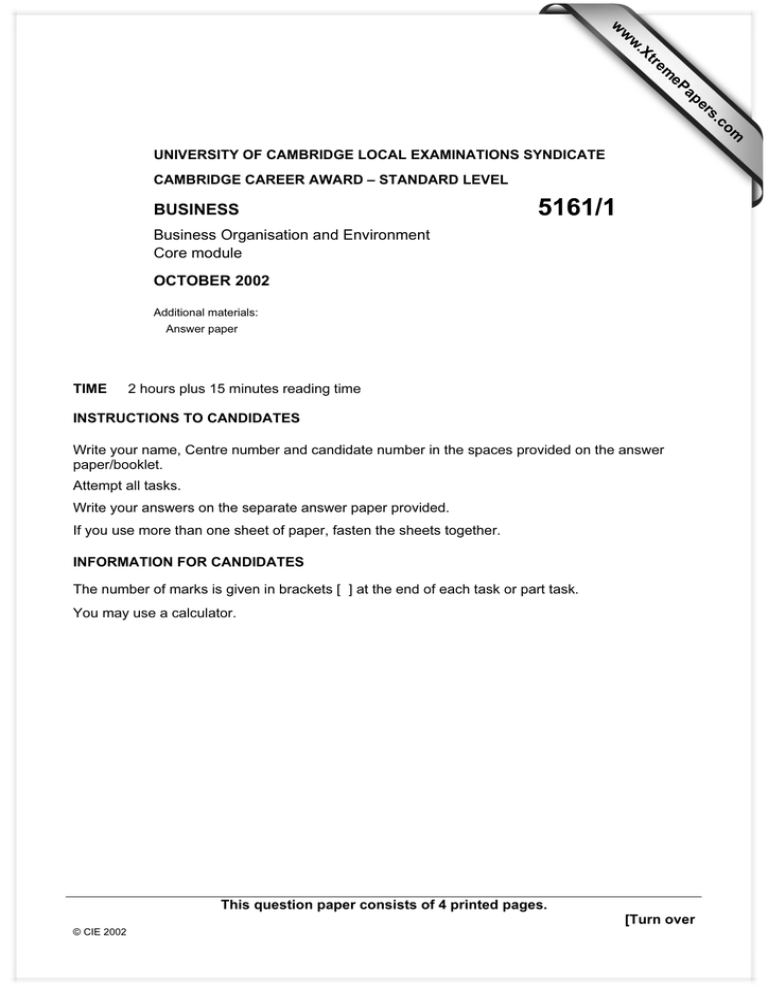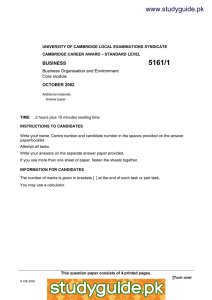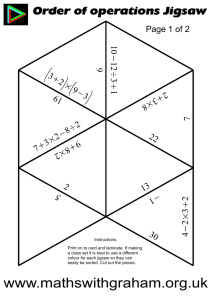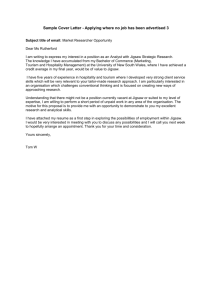BUSINESS www.XtremePapers.com Business Organisation and Environment Core module
advertisement

w w ap eP m e tr .X w om .c s er UNIVERSITY OF CAMBRIDGE LOCAL EXAMINATIONS SYNDICATE CAMBRIDGE CAREER AWARD – STANDARD LEVEL BUSINESS Business Organisation and Environment Core module OCTOBER 2002 Additional materials: Answer paper TIME 2 hours plus 15 minutes reading time INSTRUCTIONS TO CANDIDATES Write your name, Centre number and candidate number in the spaces provided on the answer paper/booklet. Attempt all tasks. Write your answers on the separate answer paper provided. If you use more than one sheet of paper, fasten the sheets together. INFORMATION FOR CANDIDATES The number of marks is given in brackets [ ] at the end of each task or part task. You may use a calculator. This question paper consists of 4 printed pages. © CIE 2002 [Turn over 2 You must read the case study below and answer all the tasks which follow. (The following case study is purely fictitious.) Case Study: Jagwant’s Jigsaw Puzzles Being good with his hands, Jagwant turned his garage into a workshop where, as a hobby, he produced simple wooden jigsaw puzzles for his children. When he was made redundant from the engineering industry he decided to work for himself and produce jigsaws for adults as well. He would produce a jigsaw puzzle from a customer’s photograph, and his work was so precise that orders soon grew and provided him with a satisfactory income. Just when the number of orders was threatening to become too much for him, five of Jagwant’s workmates who had also been made redundant came to see him with a proposition. They suggested joining Jagwant in the puzzle business as partners. They suggested that, with a properly equipped workshop, they could turn out a large enough number of puzzles in a range of sizes to employ them all. A general partnership was formed and each partner contributed $3000. Business was set up in a shop which also had a spacious workshop. The process of producing the puzzles is simple but requires skill. The partners offer six sizes of puzzle from 30 x 20 cm to 100 x 65 cm and 250 to 2500 pieces. Prices range from $15 to $25 each. The average time taken to produce a puzzle from the enlargement of the photograph to the packaging is 30 minutes. The firm now produces 400 puzzles a week with an annual turnover of $350 000. The partners are supported by one full-time business manager and two part-time employees who deal with administration, orders, supplies and the shop, and generally help out. Jagwant and his colleagues do not have a Deed of Partnership, nor do they know anything about business structure. They just work well together and each member of the business is required to do whatever needs doing. They can only survive if this is the case. Legally, partners are not employees and can be considered self-employed which raises questions about what they can expect of each other. The manager has suggested flexitime but the partners are against any such arrangement, fearing that bottlenecks might occur and deadlines would be missed. They pride themselves on immediate attention to orders. 5 10 15 20 25 Jagwant Jigsaws, being a micro-business, will survive as long as customers want special puzzles, but they have the skills to diversify into wooden toy making if required. Jagwant is aware that PEST (political, economic, social and technological) factors determine the business climate but believes his organisation is too small to be affected. The business is located in a quiet side street just off a busy town centre. About two-thirds of the business is conducted by mail order with the remaining third (i.e. more than $100 000) being placed over the counter in the shop. One of their customers suggested that if they sought a prime location in the new shopping centre they would increase their trade. Jagwant said that it would be far too expensive and might ruin the business. 30 The advertising and marketing budget is quite low. The marketing mix, which was not planned, seems to work and the partnership benefits from personal recommendation and there is much repeat business. Every month they place an advertisement in a popular newspaper and that always produces orders; they put two order forms in each jigsaw puzzle box – one for the customer and one for a friend. The shop attracts custom despite its unfashionable location. They have a simple customer relations policy – 'Complete satisfaction or your money back' – and to date no one has had cause to challenge it. The partners are aware that a displeased customer is a lost customer. 35 5161/1/O/02 40 3 You must attempt ALL of the following tasks. 1 2 Define the following terms which are used in the case study: (i) redundant (line 2) (ii) partner (line 8) (iii) part-time employees (line 17) (iv) micro-business (line 26) (v) advertising (line 35) (a) List three specific features of a partnership. [15] [5] (b) The jigsaw business has no Deed of Partnership. Briefly explain what difference a Deed might make to Jagwant’s partnership. [5] (c) Explain why Jagwant’s business could be regarded as belonging to both the secondary and tertiary sectors of the economy. [5] [Total: 15] 3 A business student visiting the organisation noticed the lack of any obvious structure. Jagwant said that he does not understand about structure and that the firm runs successfully without one. (i) Explain what a business structure is. [5] (ii) Suggest what you think Jagwant means when he says he doesn’t need a business structure. [5] [Total: 10] 4 (a) The manager has suggested Jagwant’s Jigsaws operates a flexitime system. Explain: (i) what flexitime is [5] (ii) how flexitime might benefit an employee [5] (b) Making reference to the terms, conditions, arrangements or elements of the partnership and employment, suggest: (i) what the partners should expect of one another (ii) what the three employees might expect from the firm 5161/1/O/02 [5] [5] [Total: 20] [Turn over 4 5 (a) Jagwant does not believe PEST factors affect his business. Describe to Jagwant what is meant by the business cycle and the distribution of income, and briefly suggest why they might influence his jigsaw business. [10] (b) Taking into account the general factors relating to the location of business, explain why: 6 (i) the jigsaw business prospers in a quiet side street (ii) Jagwant thinks moving into the new complex might ruin the business [5] [5] [Total: 20] (a) Using the 4Ps of the marketing mix, explain why the jigsaw business is successful. [10] (b) Jagwant’s Jigsaw Puzzles offers a personal and specialised service. Explain why it is important for the company to have a customer relations policy. [10] [Total: 20] 5161/1/O/02





